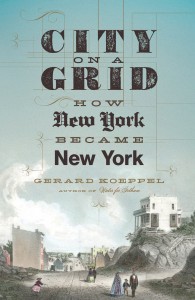Koeppel ’79 Tells History Behind New York City Grid

Readers who are fans of urban history and planning or have a particular interest in New York should find City on a Grid: How New York Became New York (Da Capo) by Gerard Koeppel ’79 a fascinating read. Koeppel shares the story behind the Manhattan street grid, created in 1811 by a three-man commission featuring headstrong Founding Father Gouverneur Morris; the plan called for a dozen parallel avenues crossing at right angles with many dozens of parallel streets in an unbroken grid.
When the grid plan was announced, New York was just under 200 years old, an overgrown town and a jumble of streets at Manhattan’s southern edge. The street planning commission decided to bring order beyond the chaos with a monolithic grid for the rest of the island. Mannahatta—the native “island of hills”—became a place of rectangles, in thousands of blocks on the flattened landscape, and numerous right-angled buildings rising vertically.

“The grid made New York an orderly place, especially in contrast with the jumbled, unplanned streets of the Dutch, English, and early American period,” Koeppel said. “The grid today makes Manhattan easily comprehensible, for people navigating the city by foot or surface transportation, up to developers siting and constructing buildings. These same benefits are also detriments. New York is not a city to happily ‘get lost’ in like Paris, nor does it possess the beauty of varied building forms and public spaces of less rigidly planned cities.”
In his recent review of the book in The New Yorker, Adam Gopnik wrote: “Koeppel argues, convincingly, that the show of hardheaded rationality here is merely a show. There was no good commercial reason to make a thrifty city of intersections at right angles. London, the model of an imperial commercial city, had its ovals and organic oddities and still prospered. Philadelphia had lovely squares interrupting its own version of the grid. Straight-sided and right-angled houses can be built in circles as well as on street corners. The details of New York’s grid turn out to be surprisingly haphazard and improvisational in their origins. As Koeppel points out, no one has ever provided a good explanation for why the wide two-way streets were chosen to fall where they do—at 14th, 23rd, 24th. In general, he persuades us, the impulse behind the grid was less the rationalizing impulses of the Enlightenment than the eternal desire of a bureaucratic commission to finish its report, accented, later, by the eternal real-estate developers’ urge to have regularized lots to develop.”
Koeppel also is the author of Bond of Union: Building the Erie Canal and the American Empire and Water for Gotham: A History.

